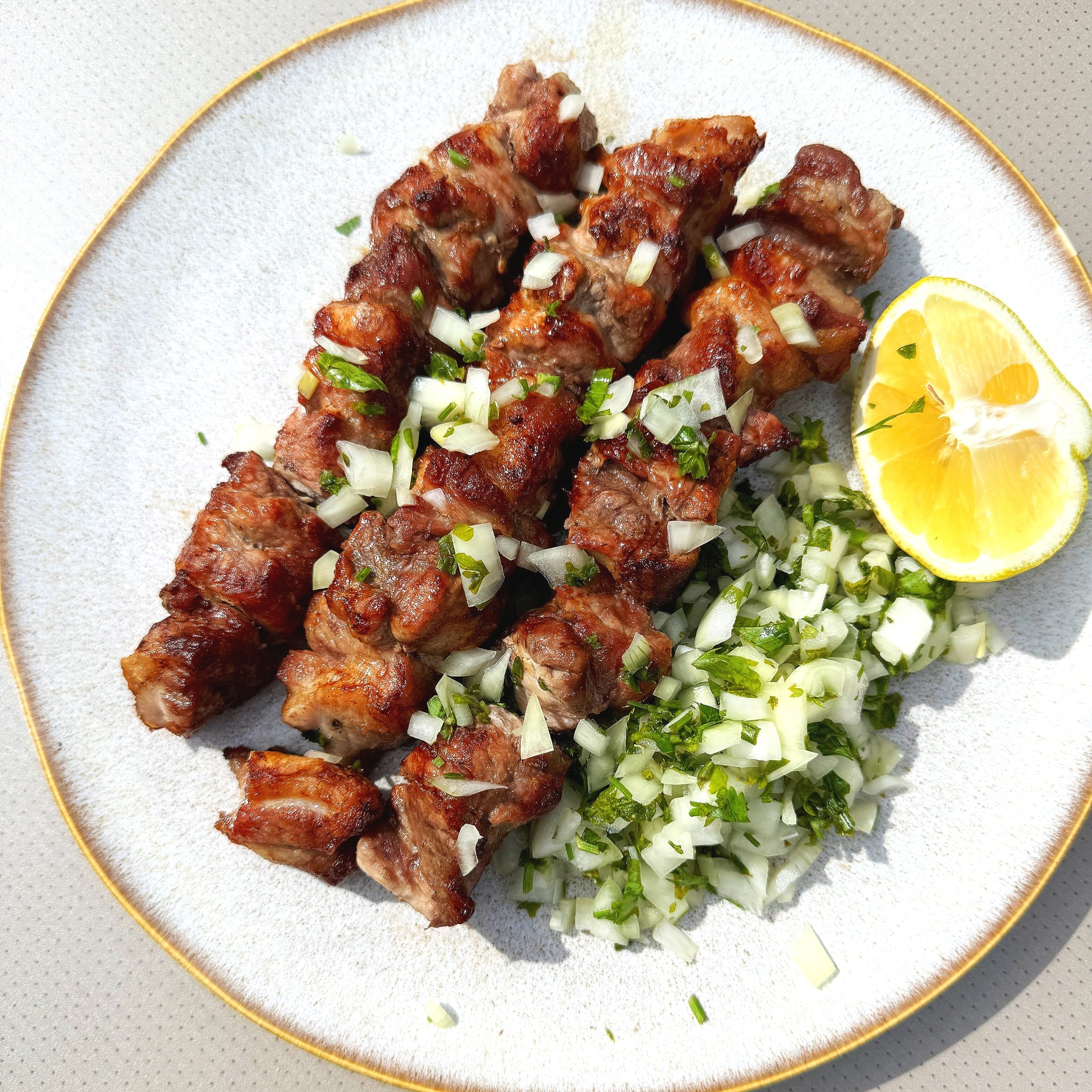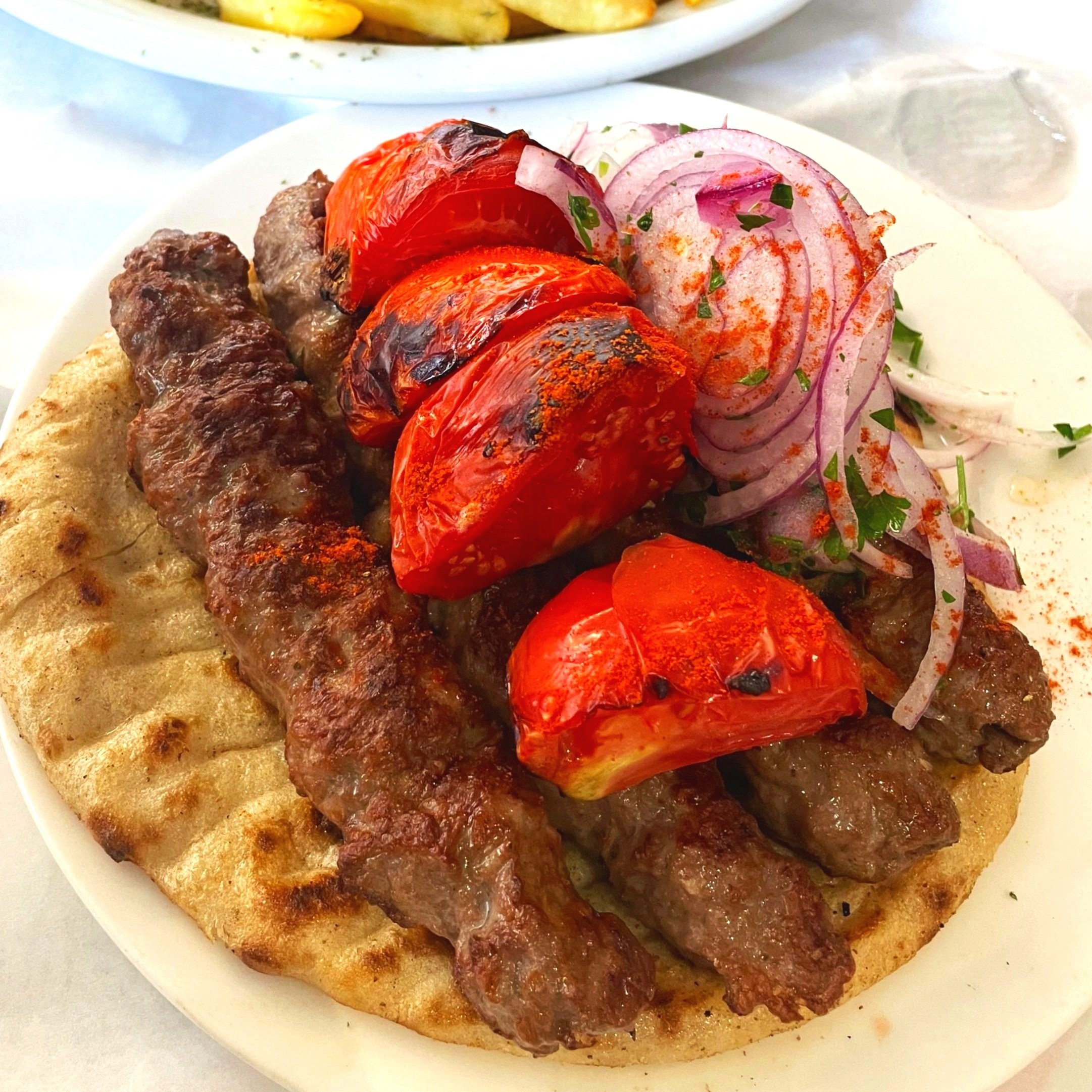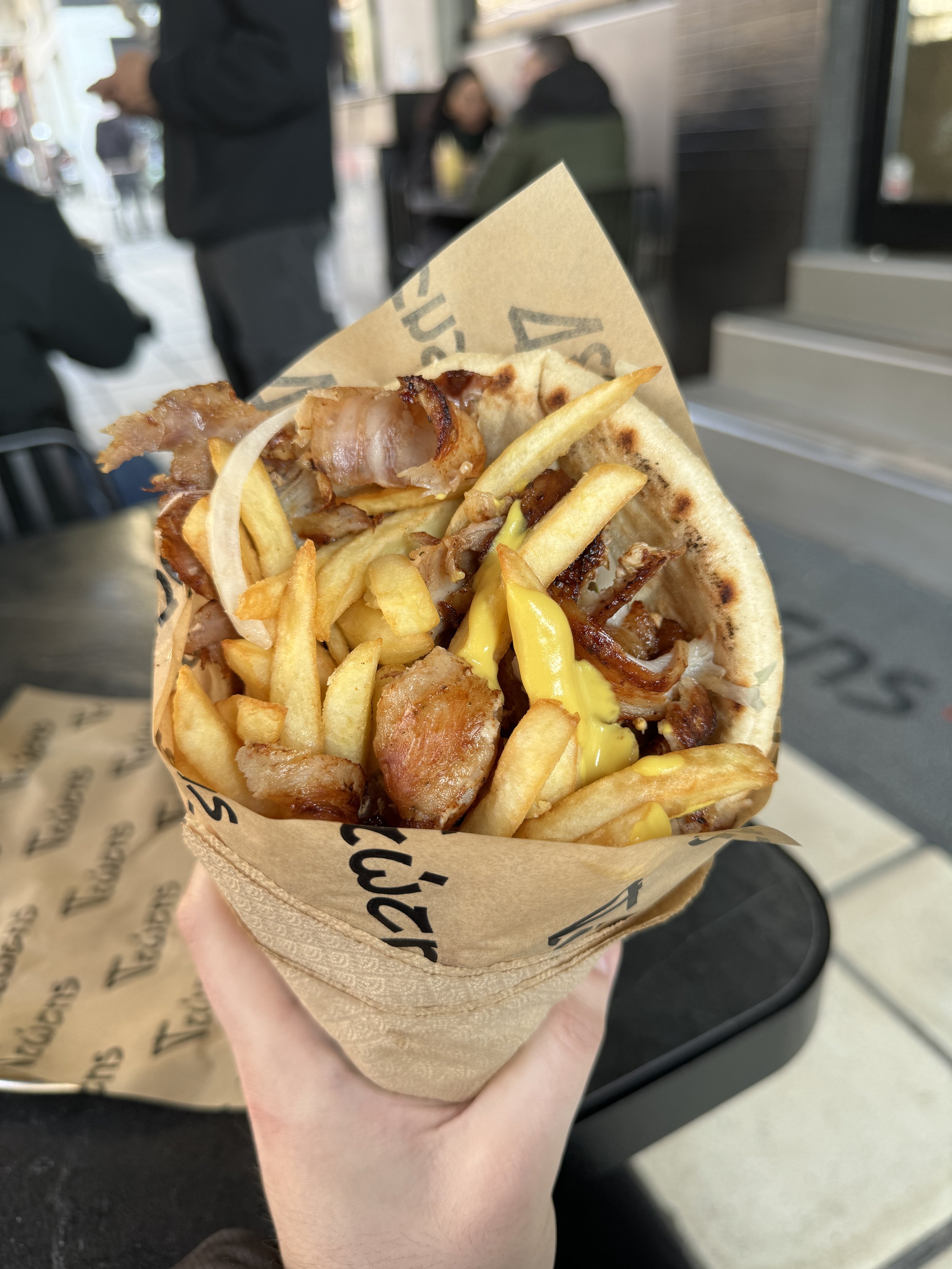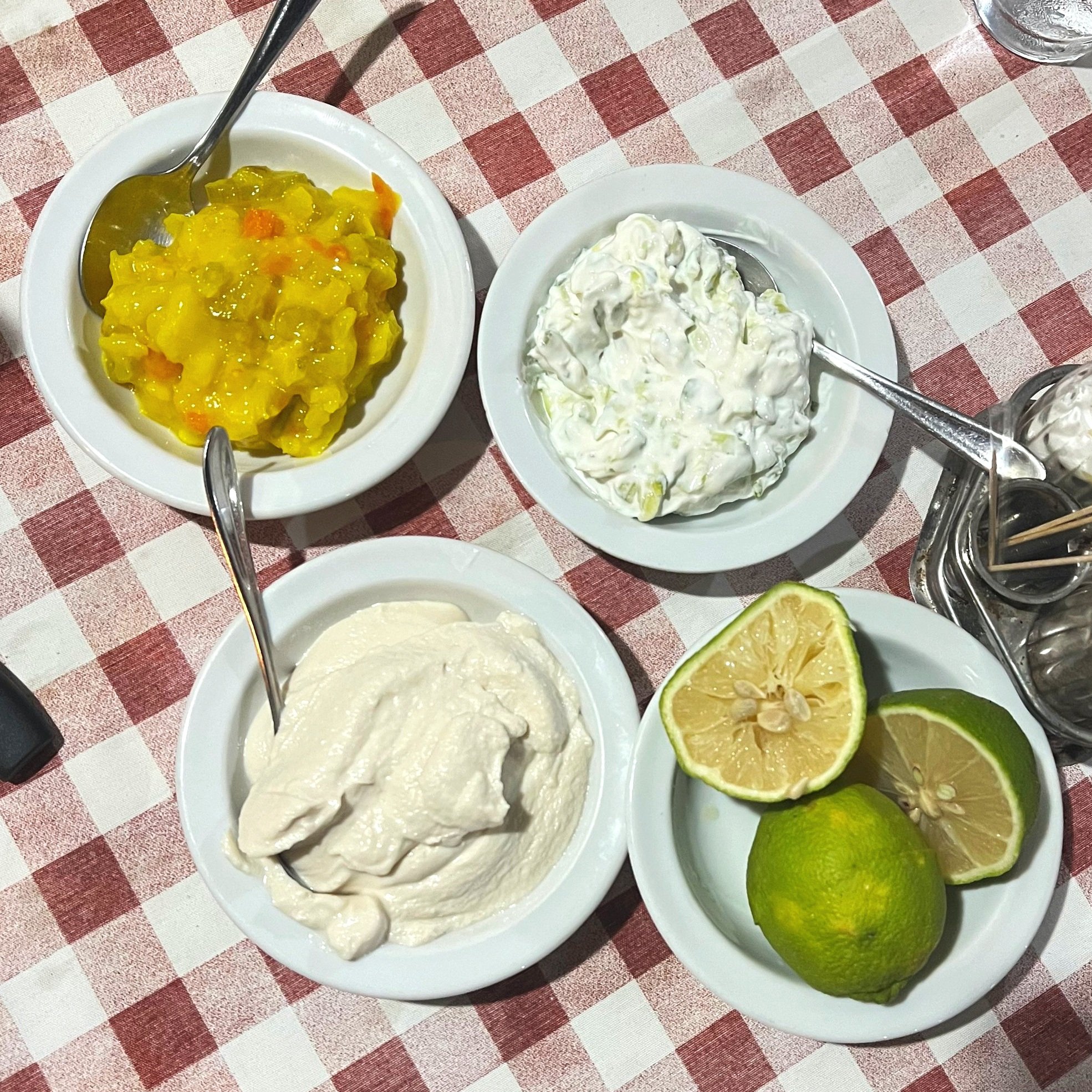What is Souvlaki?
Souvlaki
Kalamaki
Bifteki
Kebab
Gyros
Tylichto
Pitogyro
Sandwich
Sheftalia
Souvlaki Kalamaki Bifteki Kebab Gyros Tylichto Pitogyro Sandwich Sheftalia
Souvlaki: an ancient Greek tradition and Greece’s national street food.
Etymology
Souvlaki (σουβλάκι) is the diminutive of souvla, which comes from the Latin subula, meaning shoe maker’s awl. In other words, a needle. It makes sense, then, that souvla has come to be the word used by Greeks to describe the tool that they use to skewer meat.
Souvla + the diminutive suffix, ‘-ki’ = souvlaki = ‘small souvla’. The plural or souvla is souvles. The plural of souvlaki is souvlakia.
Another theory is that the word souvlaki was derived from the ancient Greek word for skewered meat. Although souvlakia have a history that dates back to the prehistoric Greece (more specifically, the Bronze Age), they had a different name entirely back then. You can find out what it was and read about the history of souvlakia soon on Souvlakination…
P.S. if you’re also wondering where gyros comes into all of this, you might want to look here.
What is a souvlaki?
This is where it gets a little complicated. In Greece, there is a light-hearted, albeit endless, regional dispute about the word ‘souvlaki’.
In theory, a souvlaki is simply a small skewer of cubed meat, but the meaning of the word varies depending on where you are exactly. So, souvlaki can mean a number of things.
What are the other words for souvlaki throughout Greece?
While, in Thessaloniki and northern Greece, souvlaki exclusively refers to the skewer, Athenians also use the term souvlaki in reference to the pita ‘wrap’ itself – regardless of whether the ‘wrap’ contains a souvlaki or another kind of meat (like kebab, bifteki, or gyros). Thessalonians would usually call this a sandwich instead. Other Greeks might also use the term pitogyro to refer to the ‘wrap’, regardless of whether or not there is any gyros in there.
So how do Athenians distinguish between a plain souvlaki skewer and the ‘wrap’? The answer is that they use another term for the plain skewer: kalamaki. You’ll also sometimes hear the word ksilaki, which essentially means ‘small wooden stick’, i.e. another word for kalamaki. There are plenty of other lesser-known ‘village’ terms that people use in different areas throughout Greece and Cyprus – if you know any that we might not, let us know! For example, although it’s not popularly known, some Cretans (especially around Rethymno) may also use another word for the kalamaki/skewer: tsita.
What is a kalamaki? Kalamaki or Souvlaki?
A kalamaki in Athens and a souvlaki in Thessaloniki are the same thing. A small skewer of meat, typically pork.
Kalamaki comes from the word kalami, which refers to a reed that grows by lakes and rivers. It was, after all, reeds that were initially used in many parts of Greece to skewer the meat… hence kalamaki. Just as souvlaki means small skewer, kalamaki means small reed (kalami).
In fact, there are still places in Greece where you can find souvlakia — or kalamakia — made using reeds. The debate arises because kalamaki is also the word for a drinking straw in Greek. In Thessaloniki and northern Greece, kalamaki only refers to the drinking straw (for frappe or freddo).
What’s the difference between souvlaki and kebab?
When Greeks use the word kebab, they’re actually referring to something else entirely: minced mutton/veal skewer. In fewer cases and places, Greeks might also use the word kebab to refer to kontosouvli or ovelias, e.g. in parts of northern Greece like Elassona.
When Greeks say ‘kebab’ this is the meat they’re most commonly referring to.
While kebab means burnt/charred in Aramaic (kabbaba), and roasted meat in Persian (kabāb), souvla, souvlaki and kalamaki all refer to the utensil used to skewer and cook the meat. They all essentially mean skewer. But psito (or ofto) is the word Greeks use for roasted meat more generally, with psito the general term that refers to meat cooked on the souvla (but not souvlakia or street food).
🧠 More meat: While souvla in Cyprus generally refers to meat cooked on the large skewer, ovelias is the term reserved specifically for the whole animal cooked on the souvla on special occasions in both Greece and Cyprus. Ofto in Cyprus more commonly appears alongside kleftiko, ofto kleftiko referring to the meat slow-cooked in the wood-fire clay oven that you can find in Greece and Cyprus. In Crete, you’ll find antikristo: meat slow-roasted on a frame that surrounds a wood fire.
What meat is used for souvlakia?
Throughout Greece, whether you call it souvlaki or kalamaki, souvlakia are, by default, made using pork meat. This means that, unless you specify otherwise, you’ll receive pork when you order a souvlaki/kalamaki. The alternative option is chicken.
It’s far less common, but you may also find souvlakia made using adult sheep (mutton, or provatína in Greek). Lamb souvlakia are even less common, despite their popularity in Greek expat communities in the English-speaking world.
That’s not to say that souvlakia can’t be made with other types of meat. After all, beef souvlakia also appear alongside pork skewers in Homer’s Iliad, the oldest literary evidence we have of it.
Preparing Souvlakia
To help expedite the process and keep the souvlakia consistent, some souvlatzides use tools like this to help skewer and cut souvlakia in large quantities simultaneously.
In Greece, souvlakia/kalamakia are made using a small wooden skewer and cooked quickly over a high heat.
The most commonly used cuts of pork are neck and shoulder, but you’ll also come across belly, loin and leg, as well as any given combination of them. Whichever you go for, souvlatzides (souvlaki makers) will often try to achieve a good balance of meat and fat for flavour.
Lots of people ask whether souvlakia/kalamakia should be marinated. Marinating souvlakia is common in Greece, but isn’t always a given. Marinades typically include anything from extra virgin olive oil, vinegar and lemon juice to oregano, thyme, paprika and mustard. The use of more ‘oriental’ spices like cumin and sumac is also not unheard of but is much less common.
You’re more likely to see souvlakia being basted with olive oil, lemon juice and some oregano while they cook. Salt is essential.
In Cyprus, souvlakia are almost never marinated – only salt is added in most cases. If they are marinated, it’s usually just with a touch of olive oil. Meat tenderisers or baking soda might also be used to tenderise the meat in some places, although many deem this to be a controversial shortcut that isn’t necessary with good-quality meat and cooking. You’ll notice when tenderisers have been added if the souvlakia leave you downing glasses of water all night.
Cooking Souvlakia
Souvlakination’s souvlakia/kalamakia/ksilakia haha.
Souvlakia in Cyprus tend to be slightly chunkier than their mainland Greek counterparts and are typically cooked using a metal skewer (smila), directly over charcoal. Whereas Greek souvlakia/kalamakia are also traditionally cooked over charcoal, wooden skewers are used instead, and they are also more likely to be cooked on top of a grill, instead of directly over the charcoal (like they are in Cyprus). (Disclaimer: you can of course find Greek-style kalamakia in Cyprus too).
Souvlakia on a Cypriot foukou, with a rotisserie motor attachment.
In Cyprus, longer skewers are placed across the barbecue so that the souvlakia are suspended directly above the charcoal. Whereas some degree of frying takes place when the meat is in contact with the grill, leading to somewhat of a different result. Foukoudes – Cypriot barbecues – and home barbecues in Greece are now made with attachments that allow for the souvlakia to be inserted and rotated by an electric motor. You rarely see this in souvlatzidika as it gives souvlatzides less control over heat and the colour of the souvlakia. It also means that you have no control over the distance between them.
In both Greece and Cyprus, souvlakia are placed closely side-by-side so as to preserve moisture and generate smoke from juices dripping onto the charcoal, which adds flavour.
As you read above, some souvlatzides might marinate the meat, others might not at all. Some in Greece may also cook the souvlakia twice, marinating the skewer in lemon and oil between the first and final grilling (sometimes with oregano, mustard and other seasonings of their choice added in).
You may also find plenty of souvlatzidika in Greek cities that cook the meat directly on a plancha, rather than a charcoal grill. Although, traditionally, charcoal would have been used, this method is widespread and established enough for decades to make it worthy of a mention, and doesn’t really seem to have many downsides. Some of the most popular souvlatzidika in Athens use this method, as it’s more practical in smaller shops that would otherwise be filled with smoke. Kostas of Agia Eirini, Kostas of Syntagma and Lefteris o Politis are all examples of some of the oldest traditional souvlatzidika in Athens who use a plancha rather than cook over charcoal directly.
How to serve souvlakia
How are Souvlakia served in Greece?
In Greece, the tradition of kalamakia/souvlakia became widespread from around the 1950s. Traditionally, they are served on the skewer, with a slice of bread, seasoned with salt and oregano, and topped with a squeeze of lemon juice (like in the first image at the start of this piece). From the 1970s, the norm was to serve souvlakia with sliced tomatoes and onions, plus a dip like tzatziki. Nowadays, if you order souvlakia as a portion (merida), you’ll probably also get fries. Greek pita bread is also commonly served with souvlakia.
In Athens, where the culture of souvlaki in pita started in the 20th Century, the traditional tylichto (wrap) consisted of the pita bread, the meat, sliced onions, oregano, and paprika. Plus tomatoes, when they were in season. Tomato salsa started to become popular in the 1950s as a way to keep the tomato flavour in the pita when tomatoes were out of season. Later, yoghurt will have been added as a condiment, before tzatziki was popularised as the go-to condiment after the 1970s (yoghurt is still a popular choice in Crete in particular). It’s at that time that chips/fries also began to be added. Noting the continual theme of the northern-southern regional variations, mustard (and ketchup) are more popular as condiments in Thessaloniki than tzatziki or red salsa. You may also find souvlakia served in different kinds of sliced bread in Thessaloniki – like the fabled souvlouri at Nterlicatesen, a compound word describing souvlaki in koulouri, in seeded ‘baguette’/frantzola form.
The variations are manifold: elsewhere in northern Greece, in places like Drama and Serres, you’ll see souvlaki and gyros served in lagána bread, the ancient Greek flatbread traditionally eaten on Clean Monday, at the start of Lent. Here, one content creator shows where you can find souvlaki served in peinirli in Drama. In Mani, in the Peloponnese, you can find souvlakia served with travichti – a pita bread that is fried to order – and a slice of kefalotyri cheese, altogether referred to as the ‘triplet’. Here’s where you can try it in Athens.
Pita gyros, or gyros sandwich in Thessaloniki. Thessalonians will make fun of Athenians, some of whom might call this a ‘souvlaki with gyros’. In both places, gyros refers to the meat that resembles doner and shawarma.
Bottom to top: chicken souvlakia, pork souvlakia, and loukanika (Greek sausage) at Kyr Giorgis in Thessaloniki.
How are Souvlakia served in Cyprus?
Souvlakia in Cyprus are served at least two different ways. They might be served as a portion, normally topped with onions, parsley and lemon juice, and sometimes alongside cucumber, tomato, and - nowadays - fries. Pittes will also usually be served alongside them. You’ll commonly see souvlakia served Cypriot pitta with tomatoes, cucumber, onions, parsley and lemon juice. In both cases, sheftalia commonly accompany souvlakia (minced pork with onion and parsley wrapped in caul fat). A mix pitta typically consists a skewer of pork with at least 2 sheftalies. If you’d like an extra skewer, ask for an enishimeni (‘enhanced’).
Souvlakia with sheftalia in Cyprus.
Cypriot mix pitta.
Dips typically served with souvlakia in Cyprus. Pikla (top left), tashi (bottom left), and tzatziki. You’ll never see souvlakia served without lemons in sight.
Shredded cabbage is another modern addition that began around the 1970s, although not all souvlatzidika will add them. Many Cypriots also love to enjoy their souvlaki with tashi – aka tahini sauce – particularly in Larnaca. Meanwhile, you’re very likely to encounter pikla – Cypriot piccalilli – in Limassol. Tzatziki is the other popular, albeit slightly more modern, choice.
What did you learn? And did we miss anything? Let us know over on Instagram :)
Further reading
Souvlaki: A gastronomic journey from Homer’s Epics to contemporary street food, Marina Petridou & Tasos Brekoulakis (2022)
Souvlaki in Athens: a story of 100 years, Marina Petridou & Tasos Brekoulakis (2 Feb 2025)
https://www.thisisathens.org/restaurants/cheap-eats/souvlaki-gyros-street-food
https://www.amberq.gr/en/grillphilosophy/greek-pork-souvlaki-an-old-traditional-recipe















